If you’re working with a client looking to expand into new markets, you need to know how to do international SEO.
International SEO is the process of optimizing websites for different countries and languages. It’s all about making sure potential customers can find a website and that it offers a great user experience for all users.
It’s tricky; you want to provide an optimized experience for all users, but that can mean very different things for users from different regions.
International SEO can be one of the toughest challenges out there for SEOs with multiple spinning plates, but don’t panic – there are some core takeaways that can make the challenge just a little bit easier.
In this guide, we will reveal everything you need to know about international SEO.
We’ll cover:
- What international SEO involves
- How to develop an international SEO strategy
- The importance of understanding your target market
- How to do keyword research for multiple languages
- How to do outreach and get local links for international sites
- International SEO technical considerations
What Is International SEO?
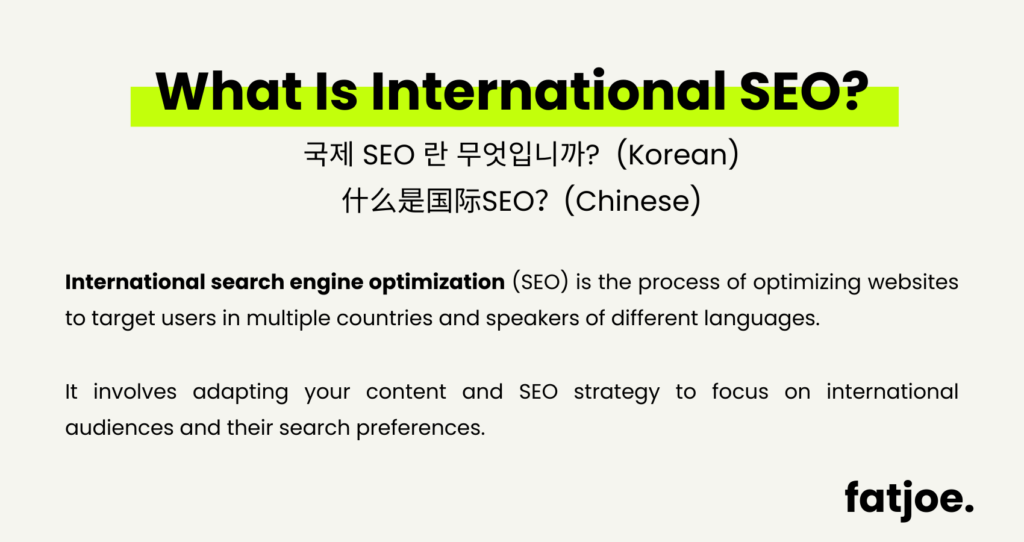
International search engine optimization (SEO) is the process of optimizing websites to target users in multiple countries and speakers of different languages. It involves adapting your content and SEO strategy to focus on international audiences and their search preferences.
The best way to understand international SEO is to compare it to local and national SEO strategies.
Local SEO targets a specific town, city, or region. The goal is to increase visibility for local searches like “Italian restaurant Seattle.” This is achieved through optimizing your Google Business Profile, achieving NAP consistency, and other strategies.
Local SEO is super important for clients like local stores and service providers.
National SEO is a more extensive strategy. It’s for businesses that operate nationwide or offer products and services not limited by location within a country. In a national SEO strategy, you target broader keywords and need a scalable content strategy to attract a large audience.
This type of SEO is for clients like ecommerce stores and businesses looking to expand nationwide.
International SEO is the most expansive type of SEO. It targets multiple countries and global audiences.
It often involves creating content in multiple languages. You also need to choose a domain structure for your international sites, optimize for search engine preferences in different countries, and gain a deep understanding of the target markets.
This type of SEO is for clients who want to build a global presence.
Core Components of an International SEO Strategy
Here’s a breakdown of the main components of international SEO:
Geotargeting
Geotargeting is about making sure your content appeals to different regional audiences. You can use tools like Google Analytics to research the behaviors and preferences of your target audience in each region.
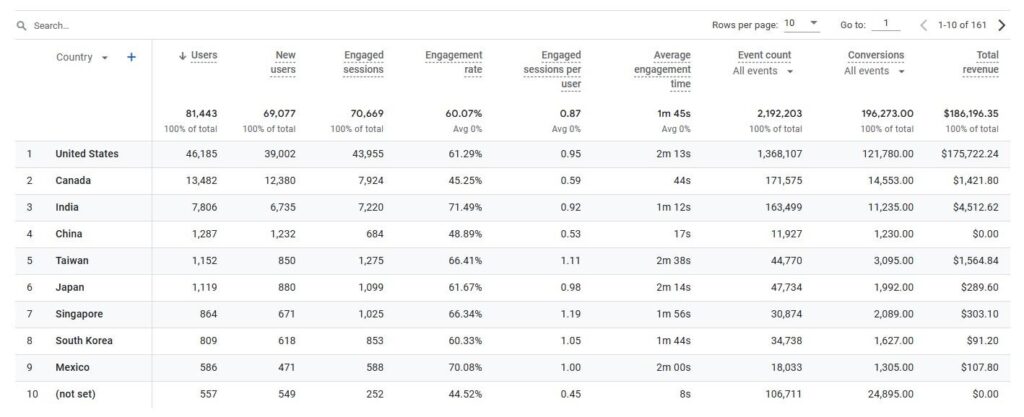
Once you understand what each audience likes, you can tailor your content to their preferences. This could involve localizing content and optimizing CTAs and other on-page elements for users from different countries.
It’s also vital to adapt your keyword strategy. That means targeting relevant keywords in different languages and variations of English keywords based on the target audience’s preferences.
Language Targeting
You need to do much more than simply translate your existing content. It’s about adapting your content based on cultural considerations.
Don’t rely on automated translation tools. Invest in a professional translation service with experience in your target region.
They can adapt the tone, style, and cultural references to resonate with the local audience.

It’s also a good idea to test your content with native speakers. You can get feedback to help you make sure your content is culturally appropriate and engaging.
Search Engine Preferences
Google is by far the most used search engine globally. But it doesn’t dominate in every region. For example, Baidu is China’s most used search engine, and Yandex is the leading player in Russia.
If you’re targeting South Korea, Yahoo still holds a significant share of the search engine market.
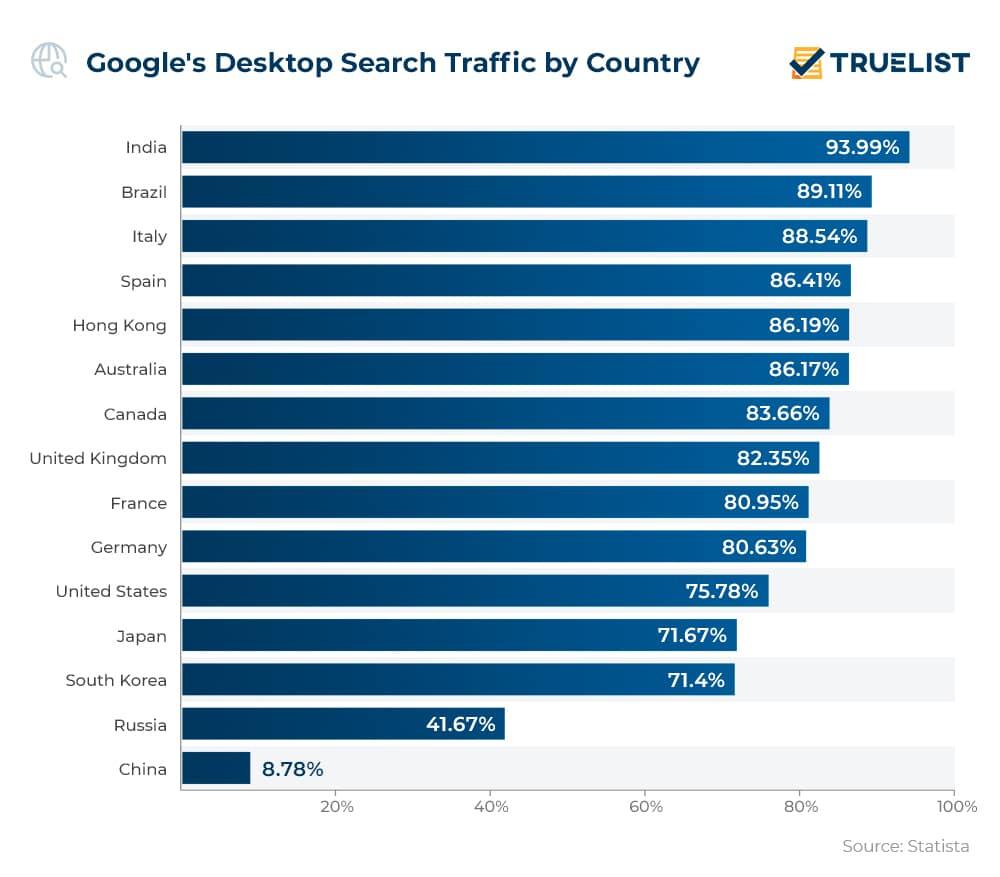
You must adapt your strategy for the popular search engines in your target markets. That means understanding how the algorithm works and updating your strategy.
For example, Baidu is much more precise when matching search results with the keywords used in a search query. Semantic SEO is less of a factor.
Technical Optimization
Technical optimization plays a significant role in international SEO. We’ll go into more detail later in the guide, but you need to cover a few key elements.
Hreflang Tags
You need to implement hreflang tags to help search engines understand the language and region you’re targeting with your content. This ensures users are directed to the right version of your site and helps you avoid duplicate content issues.
Site Structure
There are three options when it comes to site structure. You can set up a country-specific domain, subdomain, or subdirectory. Each has pros and cons that we will cover later.
Mobile and Site Speed
Whichever region you’re targeting, you should make sure your site performs well for mobile users. However, smartphone penetration is higher in some countries than in others.
It’s also important that your site is fast to load. Server location and content delivery networks can help to achieve faster loading times.
User Experience Optimization
User preferences and behaviors can vary between specific countries and regions. For example, if your client is an ecommerce store, you’ll want to offer the preferred local payment options for each market you’re targeting.
This improves the experience for users and can lead to higher conversion rates.
If your client provides customer support through their website, it’s important to offer support in the local language and account for time zone differences.
Compliance with Local Regulations
Make sure you’re aware of the laws and regulations in each target country. The big thing here is regulations on data protection and online content. For example, if you’re targeting countries in the European Union, you’ll need to comply with GDPR regulations.
HubSpot has a helpful guide on GDPR and how it impacts marketing and SEO.
If you need clarification on any legal aspects, it’s worth consulting legal experts with experience in the market you’re planning to target.
Understanding Your Client’s Target Market(s)
Understanding your client’s target market is the key to a successful international SEO campaign.
If you ignore the unique characteristics and preferences of the market, your strategy isn’t going to be effective, and you’ll miss out on opportunities.
Here are the key things you should consider:
Cultural Differences
Every country and market will have its own values, traditions, and social norms. These cultural factors can influence consumer behavior and attitudes toward products and services.
For example, the meaning and symbolism of colors can vary between cultures and impact how a brand is perceived. Red is associated with love and romance in Western countries. But in the Middle East, it is associated with danger.
Understanding these cultural differences is key to creating relevant, quality content.
Consumer Behavior
Consumer behavior and shopping habits can differ from region to region.
In some countries, shoppers prefer in-depth information and technical details about a product. In others, purchases may be more impulse-driven and based on emotion.
Understanding these behavioral patterns can help you optimize your content and landing pages.
Language Considerations
It’s not just about translating your content. You also need to understand the nuances and common expressions of the local language.
The same phrase might have a different meaning in different regions.
That’s why working with a native speaker is super important when translating your content.
The number of great companies that invest huge money in their design and copy, but then go cheap on translation and International SEO is mind boggling.
— Zeph Snapp (@ZephSnapp) May 8, 2019
They will help you make sure your content resonates with your target audience the way you intend it to.
Product Requirements
Different markets may have specific requirements for products. That can include the size, design, and even the packaging used.
This is because each region has unique local needs, climate, and cultural preferences.
While this isn’t strictly part of your SEO strategy, it is something your client needs to be aware of.
Keyword Research and Optimization for Different Languages
Keyword research is the backbone of every SEO campaign – no matter which market you are targeting.
When you’re expanding into different languages, you need to find a balance between practical considerations and linguistic accuracy.
Importance of English in International Markets
You’ll find that English is widely used as a second language in many international markets. In fact, a recent study estimated that over 1.45 billion people in the world speak English.
The most spoken languages worldwide in 2023 (by speakers in millions):
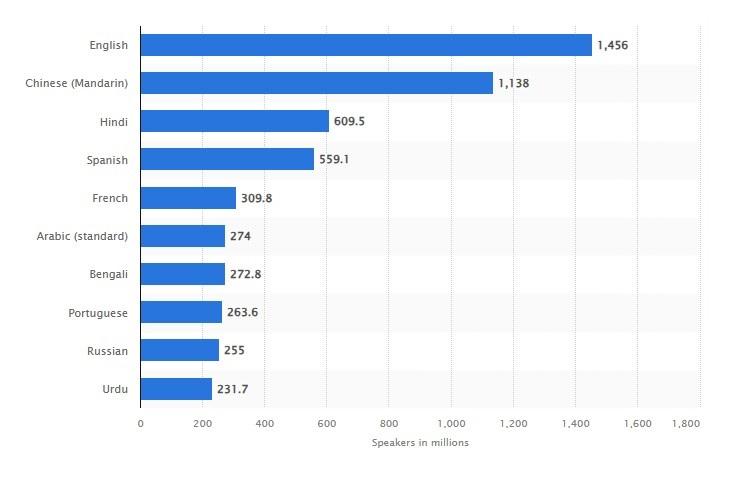
The widespread use of English can make it easier to expand into international markets. In many regions, you can reach a large audience without translating your website content into the local language.
It’s important to note that you will still need to understand the target market’s local cultural and linguistic characteristics.
You also need to choose relevant keywords that resonate with the local audience.
Tools like Ahrefs and Semrush can be useful when you conduct keyword research for your international SEO strategy. You can see the search volume of keywords in different countries.
Here’s a quick example. In the US, “sneakers” is the term that is commonly used. This is reflected in the search volume.
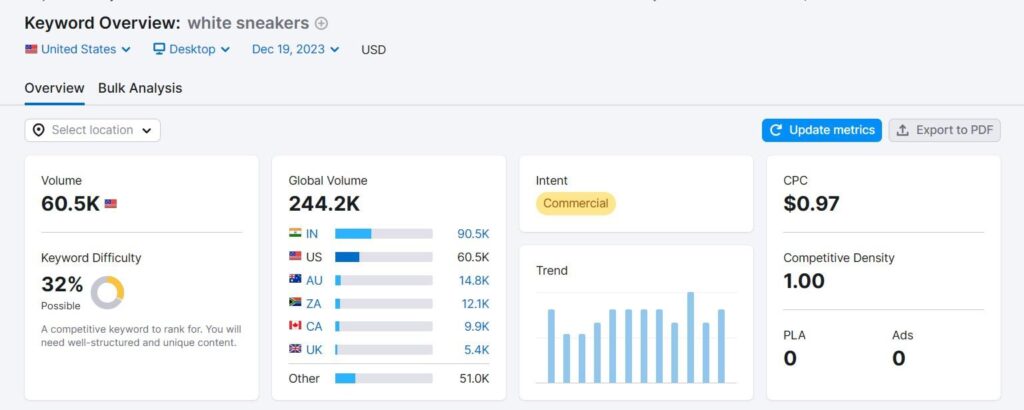
However, “trainers” is much more widely used in the UK. The term “white trainers” receives 48.8K searches per month, compared to just 5.4K for the query “white sneakers.”
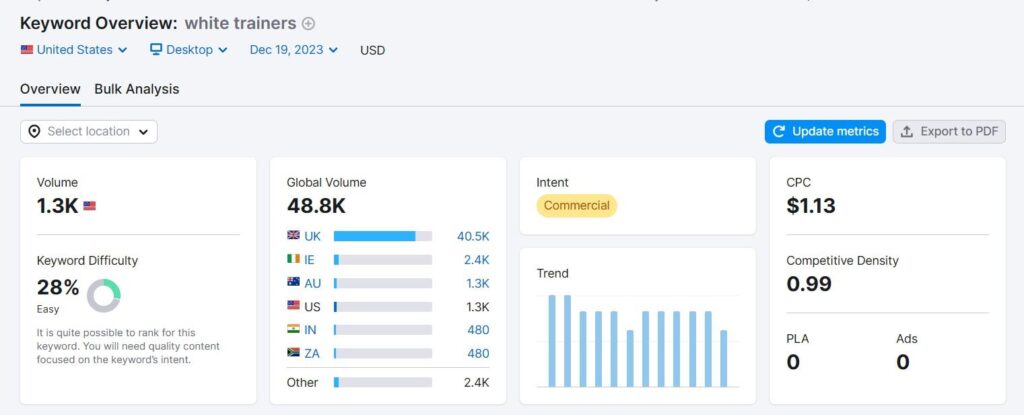
You’ll need to research the local search trends to identify which relevant English terms are commonly used and searched for.
Adapting Keyword Research For Different Languages
It’s best to work with professional translators if you decide to target countries or regions that speak different languages. They can help you translate your keywords and make sure that you’re targeting culturally and contextually appropriate search terms.
Some keywords that work well in one language may not have a direct or effective equivalent in another. So, you need to know the cultural context around the relevant keywords.
International Outreach
You need backlinks to rank high in search results. Getting local links from websites based in the market you’re targeting can make a huge impact on your search ranking and international SEO efforts.
International outreach is the process of gaining these backlinks through guest posting, blogger outreach, and other link building strategies.
First, you need to identify local link sources. These can include local news websites, blogs, industry publications, and directories.
One of the easiest ways to identify these sources is using a tool like Ahrefs or Semrush to analyze where your competitors get their links from.
You can use the domain filter to look at the referring domains in your target market.
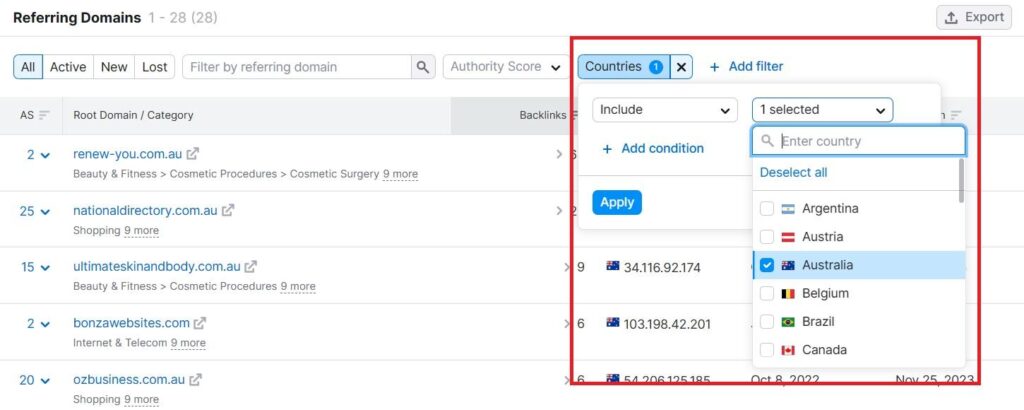
Some of these referring domains will be directories, but you’ll also find blogs and industry publications. For these sites, you’ll need to create high-quality, localized content.
Direct translation of English content is often not good enough for publication on third-party sites. You’ll need to use a professional translation service or hire a native-speaking copywriter to create your content.
You can use a multilingual outreach service like fatjoe. We can handle the international outreach for you and even create the content in the language of your target market.
In some markets, you’ll find that English content can still be effective in reaching a large audience and building quality backlinks. Focusing on English content can be more cost-effective if you have limited resources for translation and localization.
Technical Considerations for International SEO Strategies
Several technical international SEO best practices need to be taken into account when optimizing your website for international audiences. These technical elements help search engines understand your target market and languages.
They also play an important role in enhancing the user experience of your client’s website.
Choosing the Right Website Structure
There are three different options when it comes to website structure.
Country-Specific Domains (ccTLDs)
These are standalone domains for different countries. For example, you might have a .co.uk address to the UK, a .fr address for France, or a .es for Spain.

This can be a good choice if you’re heavily focusing on a specific country. The domain immediately shows search engines and users that the website is specifically made for that country.
The downside is that country-specific domains can be more expensive and time-consuming. You’ll need to manage a separate domain for each country. And each domain will have a unique backlink profile, which can weaken your domain authority.
Subdomains with Global Domains (gTLDs)
This is when you create a separate section of your main website for each country or language. For example, you might have a fr.examplesite.com for the French language.
Subdomains can be a good option if you want to avoid dealing with the hassle of buying and managing multiple domains. It’s easier to set up but may be less effective in signaling to search engines and users about the specific target country.
Subdirectories with Global Domains
Subdirectories with global domains are when you create language-specific or country-specific sections within your main website. For example, you would have examplesite.com/fr/ for French.
This method is typically the easiest to set up and manage. It also has some SEO benefits, as every version of your site shares the authority of the main domain.
However, it may be less clear to search engines that the content is specifically optimized for a particular country.
The way to get around this is to use hreflang tags.
Hreflang Tags
Hreflang tags are small pieces of code that you add to your web pages. They tell search engines what language your content is in and which country it’s targeted at.
This is important for avoiding duplicate content issues like having multiple versions of the same content in different languages.
Each language and country version of your page should have its own hreflang tag. They should also reference each other.
Search engines use these tags to make sure users in different countries are shown the right version of your site.
Search Engine Journal has a great guide on hreflang tags. You can also use free tools like Merkle to ensure you’re correctly implementing your tags.
Local Hosting and Server Location
Page speed is a confirmed Google ranking factor. One of the ways you can boost loading times and improve your site’s user experience is to host your website in the country you’re targeting.
However, if you’re targeting multiple regions, that isn’t always practical or cost-effective.
An alternative way to improve site speed for users in different regions is to use a content delivery network (CDN). A CDN stores copies of your site on multiple servers around the world. When someone visits your site, they’re served content from the nearest server.
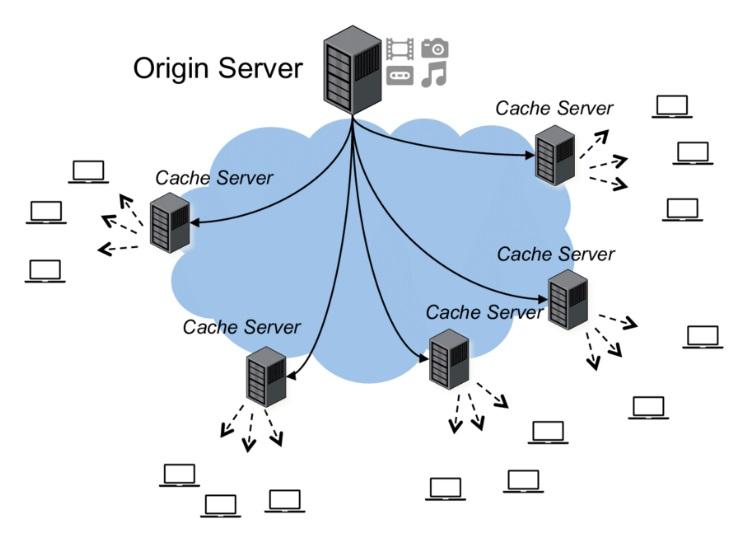
Using a CDN can have a significant impact on site speed. It’s a good way to make sure users accessing your site experience fast loading times, no matter where they are located.
Currency and Language Selection
Make it easy for users to select their preferred language and currency on your site.
The best way to do this is to add accessible options in the site’s header or footer. Here’s an example from Booking.com.

Making it easy for users to see content in their native language and prices in their local currency can significantly improve the user experience. It can have a big impact on bounce rates and conversions.
Driving Traffic and Conversions with an International SEO Strategy
International SEO isn’t something you’ll need to do for every client. But it’s a must for those seeking to expand into new regions.
Like every SEO strategy, you’ll need strong keyword research and link building tactics. You’ll also need to handle the translation of your content and a few technical considerations.
But when done correctly, you can help your clients tap into new markets and expand their global footprint.
Become a Pro at SEO
Join 65,000 others and learn the secrets to SEO success with our weekly blog posts.
